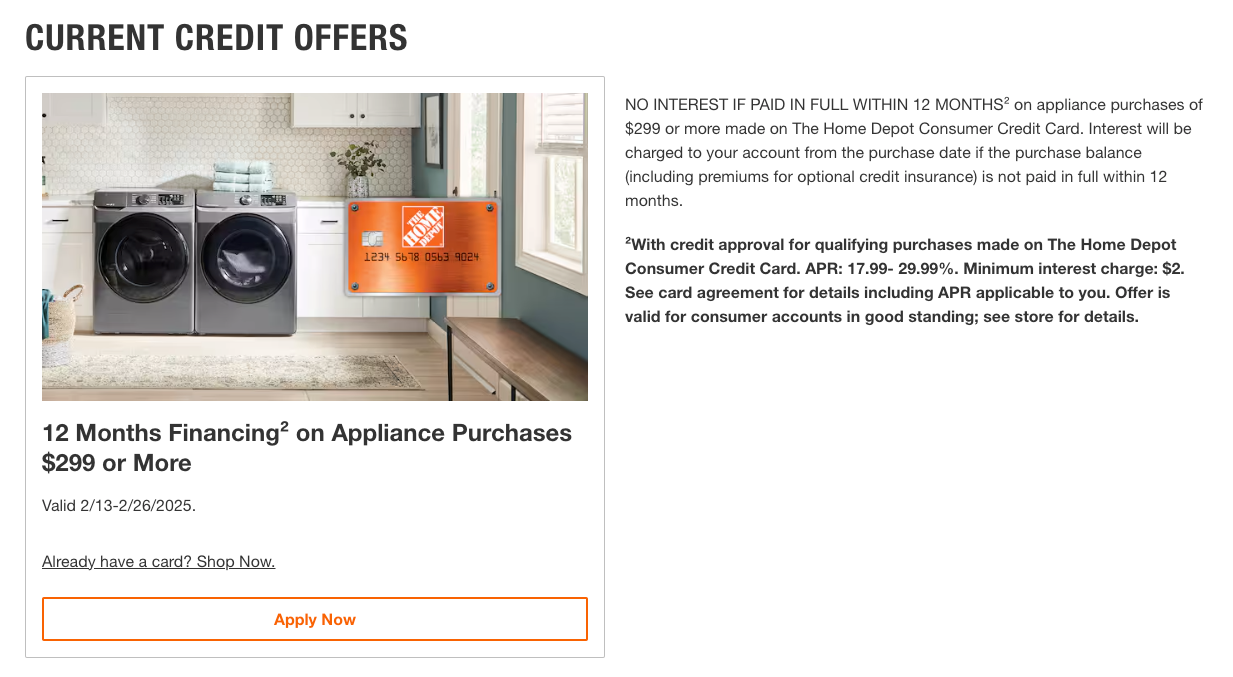The dangers of deferred interest promotions

Key takeaways
- Deferred interest promotions can sound like a great deal at first, but they’re best avoided due to their high interest rates.
- Unlike many 0 percent introductory APR offers — which help you avoid interest for a set period — deferred interest is retroactively charged, holding off until the end of the period, then charged all at once if there’s any balance remaining on the card.
- Before signing up for a deferred interest promotion, consider alternatives like 0 percent APR credit cards, HELOCs and personal loans.
The results of Bankrate’s Retail Cards Survey, released in September 2024, were shocking. The average retail card APR was a record-high 30.45 percent, which is more than ten percentage points higher than the national average for all credit cards. But that’s just the average — some store cards charge as much as 35 percent or more.
What’s even worse is that many retailer-branded credit cards dangle 0 percent promotions that are actually deferred interest offers, which can be very costly if you don’t pay your entire balance before the clock runs out.
That’s right: If you have any remaining balance when the deferred interest period expires — it doesn’t matter if it’s $1 or $1,000 — then the card issuer charges you for all the interest that would have accumulated since the beginning of the term. They do so by multiplying your average daily balance by your daily periodic rate — essentially, the daily interest rate.
There are several other potential dangers that come with deferred interest promotional financing. Let’s break them down.
Running the numbers
Here’s an example of how deferred interest plays out in the real world. Though it’s hardly the only retailer offering these types of offers, Home Depot often extends deferred interest on its retail cards. The Home Depot® Consumer Credit Card* backed by Citi, for example, offers a “12 Months Financing on Appliance Purchases” promotion of $299 or more at the time of writing.

The offer states that “Interest will be charged to your account from the purchase date if the purchase balance (including premiums for optional credit insurance) is not paid in full within 12 months,” meaning the interest from that purchase will be deferred, as opposed to not accumulating at all, during those 12 months. However, many consumers may not fully understand these deferred interest deals.
There’s also the concern of large purchases going through this process, since home improvements can be very pricey. Plenty of retailers offer deferred interest deals. Some other retailers with deferred interest promotions that tend to have larger ticket sizes include Zales, Wayfair and Best Buy, to name a few.
While it’s bad enough that you might owe retroactive interest on a couple hundred bucks you spent at Amazon, it’s quite another if it’s $12,000 in purchases toward a kitchen remodel.
The true cost of deferred interest
Say you decide to take advantage of The Home Depot’s 12 Months Financing on Appliance Purchases promotion to pay for that $12,000 kitchen rehab with an APR of 29.99 percent. If you fail to pay the entire amount within those twelve months — again, even if you have a single dollar remaining on your balance — you could be stuck with a massive retroactive interest bill.
The precise amount you’ll owe depends on how quickly you pay off your debt. But for illustration’s sake, let’s assume you intended to make twelve equal payments of $1,000, but you can only kick in $500 during the last month.
In this case, you paid $11,500 out of the $12,000 principal. Yet you won’t just be charged interest on the remaining $500 — you’ll be charged on your average daily balance going all the way back to the start of the term at an interest rate of 29.99 percent.
By our calculations, you’d owe close to $2,000 in retroactive interest, even though you paid down more than 90 percent of your balance within the allotted time.
It’s always important to try to pay your credit card bills on time and in full each month. But paying off your bill in full becomes even more important if you’re considering a deferred interest offer.
Honestly, even if you’re confident you can pay it off in time, I’d still steer clear. You know the saying about best-laid plans going awry? I would feel better about using an interest-free promotion that’s not phrased as deferred interest.— Ted Rossman, Senior Industry Analyst at Bankrate
Alternatives to deferred interest promotions
An alternative you could consider is the Wells Fargo Reflect® Card, which offers 0 percent intro APR for 21 months from account opening on qualifying balance transfers made within 120 days and on new purchases. This is not deferred interest, so if you have a balance remaining at the end of the period, you’re charged interest moving forward on whatever is left. Wells Fargo won’t go back and charge you retroactively for all the interest that would have otherwise accumulated.
This card’s has a regular 17.24%, 23.74%, or 28.99% Variable APR, depending on your creditworthiness, and the balance transfer fee is 5 percent or $5, whichever is greater.
Other options for financing large purchases include:
- Home equity lines of credit. The average home equity line of credit (HELOC) rate is 8.28 percent — still much lower than most credit cards’ interest rates. However, be aware that this approach involves putting your home on the line as collateral. The application process can be complicated and involves various fees, too.
- Personal loans. These loans often come with an easier, faster application process than HELOCs. The fact that personal loans are unsecured loans is another plus (but you should still pay the money back, of course). Rates vary widely, from the mid-single digits if you have a strong credit score all the way past 30 percent if you have lower credit. Because the typical term is much shorter than a HELOC, your monthly payments could also be much higher.
- Buy now, pay later plans. Companies such as Affirm, Afterpay and Klarna offer a variety of short-term buy now, pay later payment plans. A classic example is four interest-free payments over six weeks, but sometimes these plans last much longer (up to a few years). The fine print varies tremendously — from 0 percent interest all the way up to around 30 percent — so consider your specific terms carefully.
- Saving up until you can pay for the purchase without going into debt. It may sound old-fashioned, and it may not always be feasible, but it might be the smartest approach of all. You can also consider using a rewards credit card and paying it off right away to earn cash back or travel points.
The bottom line
Deferred interest promotions can be like a wolf in sheep’s clothing. Your supposedly interest-free promotion could end up costing you a lot of money if you fail to knock out the entire balance before the clock expires. Before signing up for one, take the time to fully understand what deferred interest means, since retroactive interest charges can be sizable.
Have a question about credit cards? Email me at ted.rossman@bankrate.com,and I’d be happy to help.
*Information about the Home Depot® Consumer Credit Card has been collected independently by Bankrate. The card details have not been reviewed or approved by the issuer.






